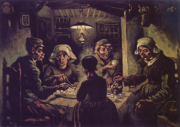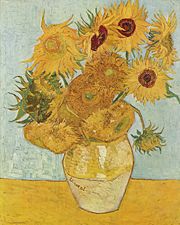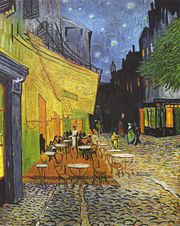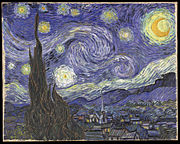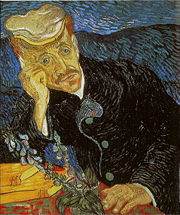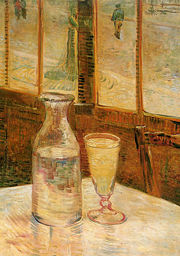Vincent van Gogh
2008/9 Schools Wikipedia Selection. Related subjects: Artists
| Vincent van Gogh | |
 Self-portrait (1887) |
|
| Birth name | Vincent Willem van Gogh |
| Born | 30 March 1853 Zundert, The Netherlands |
| Died | 29 July 1890 (aged 37) Auvers-sur-Oise, France |
| Nationality | Dutch |
| Field | Painter |
| Movement | Post-Impressionism |
Vincent Willem van Gogh ( 30 March 1853 – 29 July 1890) was a Dutch Post-Impressionist artist. His paintings and drawings include some of the world's best known, most popular and most expensive pieces.
Van Gogh spent his early adult life working for a firm of art dealers. After a brief spell as a teacher, he became a missionary worker in a very poor mining region. He did not embark upon a career as an artist until 1880. Initially, van Gogh worked only with sombre colours, until he encountered Impressionism and Neo-Impressionism in Paris. He incorporated their brighter colours and style of painting into a uniquely recognizable style, which was fully developed during the time he spent at Arles, France. He produced more than 2,000 works, including around 900 paintings and 1,100 drawings and sketches, during the last ten years of his life. Most of his best-known works were produced in the final two years of his life, during which time he cut off part of his left ear following a breakdown in his friendship with Paul Gauguin. After this he suffered recurrent bouts of mental illness, which led to his suicide.
The central figure in Van Gogh's life was his brother Theo, who continually and selflessly provided financial support. Their lifelong friendship is documented in numerous letters they exchanged from August 1872 onwards. Van Gogh is a pioneer of what came to be known as Expressionism. He had an enormous influence on 20th century art, especially on the Fauves and German Expressionists.
The Dutch pronunciation of Vincent van Gogh's name is [ˈvɪnsɛnt vɑn ˈɣɔx] . It is also often pronounced as [ˈvɪnsənt væn ˈɡɒf] or [ˈvɪnsənt vɑn ˈɡɔx] in British English and [ˈvɪnsənt væn ˈɡoʊ] in US English.
Biography
Early life (1853 – 1869)
Vincent Willem van Gogh was born in Groot-Zundert, a village close to Breda in the Province of North Brabant in the southern Netherlands. Van Gogh was the son of Anna Cornelia Carbentus and Theodorus van Gogh, who was a minister of the Dutch Reformed Church. He was given the same name as his grandfather—and a first brother stillborn exactly one year before. It has been suggested that being given the same name as his dead elder brother might have had a deep psychological impact on the young artist, and that elements of his art, such as the portrayal of pairs of male figures, can be traced back to this. The practice of reusing a name in this way was not uncommon. The name "Vincent" was often used in the Van Gogh family: the baby's grandfather was called Vincent van Gogh (1789-1874); he had received his degree of theology at the University of Leiden in 1811. Grandfather Vincent had six sons, three of whom became art dealers, including another Vincent, referred to in Van Gogh's letters as "Uncle Cent." Grandfather Vincent had perhaps been named after his own father's uncle, the successful sculptor Vincent van Gogh (1729-1802). Art and religion were the two occupations to which the Van Gogh family gravitated.
Four years after Van Gogh was born, his brother Theodorus (Theo) was born on 1 May 1857. There was also another brother named Cor and three sisters, Elisabeth, Anna and Wil. As a child, Van Gogh was serious, silent and thoughtful. In 1860 he attended the Zundert village school, where the only teacher was Catholic and there were around 200 pupils. From 1861 he and his sister Anna were taught at home by a governess, until 1 October 1864, when he went away to the elementary boarding school of Jan Provily in Zevenbergen, the Netherlands, about 20 miles (32 km) away. He was distressed to leave his family home, and recalled this even in adulthood. On 15 September 1866, he went to the new middle school, Willem II College in Tilburg, the Netherlands. Constantijn C. Huysmans, who had achieved a certain success himself in Paris, taught Van Gogh to draw at the school and advocated a systematic approach to the subject. In March 1868 Van Gogh abruptly left school and returned home. His comment on his early years was: "My youth was gloomy and cold and sterile...."
Art dealer and preacher (1869 – 1878)
In July 1869, at the age of fifteen, he obtained a position with the art dealer Goupil & Cie in The Hague through his Uncle Vincent ("Cent"), who had built up a good business which became a branch of the firm. After his training, Goupil transferred him to London in June 1873, where he lodged at 87 Hackford Road, Brixton and worked at Messrs. Goupil & Co., 17 Southampton Street. This was a happy time for Van Gogh: he was successful at work, and was already, at the age of 20, earning more than his father. He fell in love with his landlady's daughter, Eugénie Loyer, but when he finally confessed his feeling to her, she rejected him, saying that she was already secretly engaged to a previous lodger. Vincent became increasingly isolated and fervent about religion. His father and uncle sent him to Paris, where he became resentful at how art was treated as a commodity, and he manifested this to the customers. On 1 April 1876, it was agreed that his employment should be terminated.
His religious emotion grew to the point where he felt he had found his true vocation in life, and he returned to England to do unpaid work, first as a supply teacher in a small boarding school overlooking the harbour in Ramsgate; he made some sketches of the view. The proprietor of the school relocated to Isleworth, Middlesex. Vincent decided to walk to the new location. This new position did not work out, and Vincent became a nearby Methodist minister's assistant in wanting to "preach the gospel everywhere."
At Christmas that year he returned home, and then worked in a bookshop in Dordrecht for six months, but he was not happy in this new position and spent most of his time in the back of the shop either doodling, or translating passages from the Bible into English, French, and German. His roommate from this time, a young teacher called Görlitz, later recalled that Vincent ate frugally, preferring to eat no meat. In an effort to support his wish to become a pastor, his family sent him to Amsterdam in May 1877 where he lived with his uncle Jan van Gogh, a rear admiral in the navy. Vincent prepared for university, studying for the theology entrance exam with his uncle Johannes Stricker, a respected theologian who published the first "Life of Jesus" available in the Netherlands. Vincent failed at his studies and had to abandon them. He left uncle Jan's house in July 1878. He then studied, but failed, a three-month course at the Protestant missionary school (Vlaamsche Opleidingsschool) in Laeken, near Brussels.
Borinage and Brussels (1879 – 1880)
In January 1879 Van Gogh got a temporary post as a missionary in the village of Petit Wasmes in the coal-mining district of Borinage in Belgium, bringing his father's profession to people felt to be the most wretched and hopeless in Europe. Taking Christianity to what he saw as its logical conclusion, Vincent opted to live like those he preached to, sharing their hardships to the extent of sleeping on straw in a small hut at the back of the baker's house where he was billeted; the baker's wife used to hear Vincent sobbing all night in the little hut. His choice of squalid living conditions did not endear him to the appalled church authorities, who dismissed him for "undermining the dignity of the priesthood." After this he walked to Brussels, returned briefly to the Borinage, to the village of Cuesmes, but acquiesced to pressure from his parents to come "home" to Etten. He stayed there until around March the following year, to the increasing concern and frustration of his parents. There was considerable conflict between Vincent and his father, and his father made enquiries about having his son committed to a lunatic asylum at Geel. Vincent fled back to Cuesmes where he lodged with a miner named Charles Decrucq, with whom he stayed until October. He became increasingly interested in the everyday people and scenes around him, which he recorded in drawings.
In 1880, Vincent followed the suggestion of his brother Theo and took up art in earnest. In autumn 1880, he went to Brussels, intending to follow Theo's recommendation to study with the prominent Dutch artist Willem Roelofs, who persuaded Van Gogh (despite his aversion to formal schools of art) to attend the Royal Academy of Art. There he not only studied anatomy, but the standard rules of modelling and perspective, all of which, he said, "you have to know just to be able to draw the least thing." Vincent wished to become an artist while in God's service as he stated, "to try to understand the real significance of what the great artists, the serious masters, tell us in their masterpieces, that leads to God; one man wrote or told it in a book; another in a picture."
Etten (1881)
In April 1881, Van Gogh went to live in the countryside with his parents in Etten and continued drawing, using neighbours as subjects. Through the summer he spent much time walking and talking with his recently widowed cousin, Kee Vos-Stricker, the daughter of his mother's older sister and Johannes Stricker, who had shown real warmth towards his nephew. Kee was seven years older than Vincent, and had an eight-year-old son. Vincent proposed marriage, but she flatly refused with the words: "No, never, never" (niet, nooit, nimmer). At the end of November he wrote a strong letter to Uncle Stricker, and then, very soon after, hurried to Amsterdam where he talked with Stricker again on several occasions, but Kee refused to see him at all. Her parents told him "Your persistence is disgusting". In desperation he held his left hand in the flame of a lamp, saying, "Let me see her for as long as I can keep my hand in the flame." He did not clearly recall what happened next, but assumed that his uncle blew out the flame. Her father, "Uncle Stricker," as Vincent refers to him in letters to Theo, made it clear that there was no question of Vincent and Kee marrying, given Vincent's inability to support himself financially. What he saw as the hypocrisy of his uncle and former tutor affected Vincent deeply. At Christmas he quarreled violently with his father, even refusing a gift of money, and immediately left for The Hague.
Drenthe and The Hague (1881 – 1883)
In January 1882 he settled in The Hague, where he called on his cousin-in-law, the painter Anton Mauve, who encouraged him towards painting. He soon fell out with Mauve, however, perhaps over the issue of drawing from plaster casts; Mauve appeared suddenly to go cold towards Vincent, not returning a couple of his letters. Vincent guessed that Mauve had learned of his new domestic relationship with the alcoholic prostitute, Clasina Maria Hoornik (born February 1850, The Hague; she was known as Sien) and her young daughter. Van Gogh had met Sien towards the end of January. Sien had a five year-old daughter, and was pregnant. She had already had two other children who had died, although Vincent was unaware of this. On 2 July, Sien gave birth to a baby boy, Willem. When Vincent's father discovered the details of this relationship, considerable pressure was put on Vincent to abandon Sien and her children. Vincent was at first defiant in the face of his family's opposition.
His uncle Cornelis, an art dealer, commissioned 20 ink drawings of the city from him; they were completed by the end of May. In June Vincent spent three weeks in a hospital suffering gonorrhoea. In the summer, he began to paint in oil. In autumn 1883, after a year with Sien, he abandoned her and the two children. Vincent had thought of moving the family away from the city, but in the end he made the break. It is possible that lack of money had pushed Sien back to prostitution; the home had become a less happy one, and Vincent may have felt family life was irreconcilable with his artistic development. When Vincent left, Sien gave her daughter to her mother, and baby Willem to her brother, and moved to Delft and then Antwerp. Willem remembered being taken to visit his mother in Rotterdam at around the age of 12, where his uncle tried to persuade Sien to marry in order to legitimize the child. Willem remembered his mother saying: "But I know who the father is. He was an artist I lived with nearly 20 years ago in The Hague. His name was Van Gogh." She then turned to Willem and said "You are called after him." Willem believed himself to be Van Gogh's son, but the timing of the birth makes this unlikely. In 1904 Sien drowned herself in the river Scheldt.
Van Gogh moved to the Dutch province of Drenthe in the north of the Netherlands, and in December, driven by loneliness, to stay with his parents who were by then living in Nuenen, North Brabant, also in the Netherlands.
Nuenen (1883 – 1885)
In Nuenen, he devoted himself to drawing—paying boys to bring him birds' nests— and rapidly sketching the weavers in their cottages. In autumn 1884, a neighbour's daughter, Margot Begemann, ten years older than Vincent, accompanied him constantly on his painting forays and fell in love, which he reciprocated (though less enthusiastically). They agreed to marry, but were opposed by both families. Margot tried to kill herself with strychnine and Vincent rushed her to the hospital.
On 26 March 1885, Van Gogh's father died of a stroke. Van Gogh grieved deeply. For the first time there was interest from Paris in some of his work. In spring he painted what is now considered his first major work, The Potato Eaters (Dutch De Aardappeleters). In August his work was exhibited for the first time, in the windows of a paint dealer, Leurs, in The Hague. In September he was accused of making one of his young peasant sitters pregnant, and the Catholic village priest forbade villagers from modelling for him.
During his time in Nuenen Van Gogh's palette was of sombre earth tones, particularly dark brown, and he showed no sign of developing the vivid colouration that distinguishes his later, best known work. (When Vincent complained that Theo was not making enough effort to sell his paintings in Paris, Theo replied that they were too dark and not in line with the current style of bright Impressionist paintings.) During his two-year stay in Nuenen, he completed numerous drawings and watercolours, and nearly 200 oil paintings.
Antwerp (1885 – 1886)
In November 1885 he moved to Antwerp and rented a little room above a paint dealer's shop in the Rue des Images (Lange Beeldekensstraat). He had little money and ate poorly, preferring to spend what money his brother Theo sent to him on painting materials and models. Bread, coffee, and tobacco were his staple intake. In February 1886 he wrote to Theo saying that he could only remember eating six hot meals since May of the previous year. His teeth became loose and caused him much pain. While in Antwerp he applied himself to the study of colour theory and spent time looking at work in museums, particularly the work of Peter Paul Rubens, gaining encouragement to broaden his palette to carmine, cobalt and emerald green. He also bought some Japanese Ukiyo-e woodcuts in the docklands, which he imitated and incorporated into the background of some of his paintings. It was while he was living in Antwerp that Vincent began to drink absinthe heavily. He was treated by Dr Cavenaile whose surgery was near the docklands, possibly for syphilis; the treatment of alum irrigations and sitz baths was jotted down by Vincent in one of his notebooks.
In January 1886 he matriculated at the Academy of Fine Arts in Antwerp, studying painting and drawing. Despite disagreements over his rejection of academic teaching, he nevertheless took the higher-level admission exams. For most of February he was ill, run down by overwork and a poor diet (and excessive smoking).
Paris (1886 – 1888)
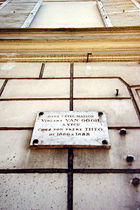
In March 1886 he moved to Paris to study at Fernand Cormon's studio, and in May 1886 his mother and sister Wil moved to Breda. The brothers first shared Theo's Rue Laval apartment on Montmartre. In June they took a larger flat at 54 Rue Lepic, further uphill. As there was no longer the need to communicate by letters, less is known about Van Gogh's time in Paris than earlier or later periods of his life.
For some months Vincent worked at Cormon's studio where he frequented the circle of the British-Australian artist John Peter Russell, and met fellow students like Émile Bernard and Henri de Toulouse-Lautrec, who used to meet at the paint store run by Julien "Père" Tanguy, which was at that time the only place to view works by Paul Cézanne.
It was not difficult to see and study Impressionist works in Paris at this time. In 1886, for example, two large vanguard exhibitions were staged, the 8th and final exhibition of the Impressionists and an exhibition of the Artistes Indépendants. In these shows Neo-Impressionism made its first appearance; works of Georges Seurat and Paul Signac were the talk of the town. Though Theo, too, kept a stock of Impressionist paintings in his gallery on Boulevard Montmarte, by artists including Claude Monet, Alfred Sisley, Edgar Degas and Camille Pissarro, Vincent evidently had problems acknowledging these recent ways to see and paint. Conflicts arose, and at the turn of 1886 to 1887 Theo found shared life with Vincent "almost unbearable," but in spring 1887 they made peace. Then Vincent set out for a campaign in Asnières, where he became personally acquainted with Paul Signac. Vincent and his friend Emile Bernard, who lived with parents in Asnières, adopted elements of the "pointillé" (pointillism) style, where many small dots are applied to the canvas, resulting in an optical blend of hues, when seen from a distance. The theory behind this also stresses the value of complementary colours (for example, blue and orange), which form vibrant contrasts and enhance each other, when juxtaposed.
In November 1887, Theo and Vincent met and befriended Paul Gauguin, who had just arrived in Paris. Towards the end of the year, Vincent arranged an exhibition of paintings by himself, Bernard, Anquetin and (probably) Toulouse-Lautrec in the Restaurant du Chalet, on Montmartre. There, Bernard and Anquetin sold their first painting, and Vincent exchanged work with Gauguin, who soon departed to Pont-Aven. But the discussions on art, artists and their social situation started during this exhibition continued, and expanded to visitors of the show like Pissarro and his son, Signac and Seurat. Finally in February 1888, when Vincent felt worn out from life in Paris, he left the city, having painted over 200 paintings during his two years there. Only hours before his departure, accompanied by Theo, he paid his first and only visit to Seurat in his atelier.
Arles (February 1888 – May 1889)
Van Gogh arrived on 21 February 1888, at the railroad station in Arles, crossed Place Lamartine, entered the city through the Porte de la Cavalerie, and took quarters a few steps further, at the Hôtel-Restaurant Carrel, 30 Rue Cavalerie. He had ideas of founding a Utopian art colony. His companion for two months was the Danish artist, Christian Mourier-Petersen. In March, he painted local landscapes, using a gridded "perspective frame." Three of his pictures were shown at the annual exhibition of the Société des Artistes Indépendants. In April he was visited by the American painter, Dodge MacKnight, who was resident in Fontvieille nearby.
On 1 May he signed a lease for 15 francs a month to rent the four rooms in the right hand side of the " Yellow House" (so called because its outside walls were yellow) at No. 2 Place Lamartine. The house was unfurnished and had been uninhabited for some time so he was not able to move in straight away. He had been staying at the Hôtel Restaurant Carrel in the Rue de la Cavalerie, just inside the medieval gate to the city, with the old Roman Arena in view. The rate charged by the hotel was 5 francs a week, which Van Gogh regarded as excessive. He disputed the price, and took the case to the local arbitrator who awarded him a twelve franc reduction on his total bill. On 7 May he moved out of the Hôtel Carrel, and moved into the Café de la Gare. He became friends with the proprietors, Joseph and Marie Ginoux. Although the Yellow House had to be furnished before he could fully move in, Van Gogh was able to use it as a studio. His major project at this time was a series of paintings intended to form the décoration for the Yellow House.
In June he visited Saintes-Maries-de-la-Mer. He gave drawing lessons to a Zouave second lieutenant, Paul-Eugène Milliet, who also became a companion. MacKnight introduced him to Eugène Boch, a Belgian painter, who stayed at times in Fontvieille (they exchanged visits in July). Gauguin agreed to join him in Arles. In August he painted sunflowers; Boch visited again. On 8 September, upon advice from his friend the station's postal supervisor Joseph Roulin, he bought two beds, and he finally spent the first night in the still sparsely furnished Yellow House on 17 September.;

On 23 October Gauguin eventually arrived in Arles, after repeated requests from Van Gogh. During November they painted together. Uncharacteristically, Van Gogh painted some pictures from memory, deferring to Gauguin's ideas in this. Their first joint outdoor painting exercise was conducted at the picturesque Alyscamps. It was in November that Van Gogh painted The Red Vineyard.
In December the two artists visited Montpellier and viewed works by Courbet and Delacroix in the Museé Fabre. However, their relationship was deteriorating badly. They quarrelled fiercely about art. Van Gogh felt an increasing fear that Gauguin was going to desert him, and what he described as a situation of "excessive tension" reached a crisis point on 23 December 1888, when Van Gogh stalked Gauguin with a razor and then cut off the lower part of his own left ear lobe, which he wrapped in newspaper and gave to a prostitute named Rachel in the local brothel, asking her to "keep this object carefully." Gauguin left Arles and did not see Van Gogh again. Van Gogh was hospitalised and in a critical state for a few days. He was immediately visited by Theo (whom Gauguin had notified), as well as Madame Ginoux and frequently by Roulin. In January 1889 Van Gogh returned to the "Yellow House", but spent the following month between hospital and home, suffering from hallucinations and paranoia that he was being poisoned. In March the police closed his house, after a petition by thirty townspeople, who called him fou roux ("the redheaded madman"). Signac visited him in hospital and Van Gogh was allowed home in his company. In April he moved into rooms owned by Dr. Rey, after floods damaged paintings in his own home. On 17 April Theo married Johanna Bonger in Amsterdam.
Saint-Rémy (May 1889 – May 1890)
On 8 May 1889 Van Gogh, accompanied by a carer, the Reverend Salles, committed himself to the mental hospital of Saint-Paul-de-Mausole in a former monastery in Saint Rémy de Provence, a little less than 20 miles (32 km) from Arles. The monastery was a mile and a half out of the town and was in an area of cornfields, vineyards, and olive trees. The hospital was run by a former naval doctor, Dr. Théophile Peyron, who had no specialist qualifications. Theo van Gogh arranged for his brother to have two small rooms, one for use as a studio, although in reality they were simply adjoining cells with barred windows. During his stay there, the clinic and its garden became his main subject. At this time some of his work was characterised by swirls, as in one of his best-known paintings, The Starry Night. He took some short supervised walks, which gave rise to images of cypresses and olive trees, but because of the shortage of subject matter due to his limited access to the outside world, he painted interpretations of Millet's paintings, as well as his own earlier work. In September 1889 he painted two new versions of the Bedroom in Arles, and in February 1890 he painted four portraits of L'Arlésienne (Madame Ginoux), based directly on a charcoal sketch Gauguin had produced when Madame Ginoux had sat for both artists at the beginning of November 1888.
In January 1890, his work was praised by Albert Aurier in the Mercure de France, and he was called a genius. In February, invited by Les XX, a society of avant-garde painters in Brussels, he participated in their annual exhibition. When, at the opening dinner, Henry de Groux, a member of Les XX, insulted Van Gogh's works, Toulouse-Lautrec demanded satisfaction, and Signac declared, he would continue to fight for Van Gogh's honour, if Lautrec should be surrendered. Later, when Van Gogh's exhibit was on display with the Artistes Indépendants in Paris, Monet said that his work was the best in the show.
Auvers-sur-Oise (May – July 1890)
In May 1890, Van Gogh left the clinic and went to the physician Dr. Paul Gachet, in Auvers-sur-Oise near Paris, where he was closer to his brother Theo. Dr. Gachet had been recommended to him by Pissarro, as he had previously treated several artists and was an amateur artist himself. Van Gogh's first impression was that Gachet was "sicker than I am, I think, or shall we say just as much." Later Van Gogh did two portraits of Gachet in oils, as well as a third—his only etching, and in all three emphasis is on Gachet's melancholic disposition. In his last weeks at Saint-Rémy Van Gogh's thoughts had been returning to his "memories of the North", and several of the approximately 70 oils he painted during his 70 days in Auvers-sur-Oise—such as The Church at Auvers—are reminiscent of northern scenes.
Wheat Field with Crows—an example of the unusual double square canvas-size he used in the last weeks of his life—with its turbulent intensity is often, but mistakenly, thought to be Van Gogh's last work ( Jan Hulsker lists seven paintings after it). Daubigny's Garden is a more likely candidate. There are also seemingly unfinished paintings, such as Thatched Cottages by a Hill.
Van Gogh's depression deepened, and on 27 July 1890, at the age of 37, he walked into the fields and shot himself in the chest with a revolver. Without realizing that he was fatally wounded he returned to the Ravoux Inn where he died in his bed two days later. Theo hastened to be at his side and reported his last words as "La tristesse durera toujours" (French for "the sadness will last forever"). Vincent was buried at the cemetery of Auvers-sur-Oise. Theo had contracted syphilis—though this was not admitted by the family for many years—and not long after Vincent's death, was himself admitted to hospital. He was not able to come to terms with the grief of his brother's absence, and died six months later on 25 January at Utrecht. In 1914 Theo's body was exhumed and re-buried beside Vincent.
Medical records
Van Gogh cut off the lobe of his left ear during some sort of seizure on 24 December 1888. Mental problems afflicted him, particularly in the last few years of his life. During some of these periods he did not paint or was not allowed to. There has been much debate over the years as to the source of Van Gogh's mental illness and its effect on his work. Over 150 psychiatrists have attempted to label his illness, and some 30 different diagnoses have been suggested.
Diagnoses which have been put forward include schizophrenia, bipolar disorder, syphilis, poisoning from swallowed paints, temporal lobe epilepsy and acute intermittent porphyria. Any of these could have been the culprit and been aggravated by malnutrition, overwork, insomnia, and a fondness for alcohol, and absinthe in particular.
Medical theories have even been proposed to explain Van Gogh's use of the colour yellow. One theory holds that Van Gogh's colour vision might have been affected by his love of absinthe, a liquor that contains a neurotoxin called thujone. High doses of thujone can cause xanthopsia: seeing objects in yellow. However, a 1991 study indicated that an absinthe drinker would become unconscious from the alcohol content long before consuming enough thujone to develop yellow vision. Another theory suggests that Dr. Gachet might have prescribed digitalis to Van Gogh as a treatment for epilepsy. There is no direct evidence that he ever took digitalis, but he did paint Gachet with some cut flower stalks of Common Foxglove, the plant from which the drug is derived. Those who take large doses of digitalis often report yellow-tinted vision or yellow spots surrounded by coronas (like those in the The Starry Night) and changes in overall colour perception.
A recently proposed illness is lead poisoning. The paints he used were lead-based, and one of the symptoms of lead poisoning results in a swelling of the retina, which may have led to the halo effect seen in many of Van Gogh's later works. It has been suggested that Van Gogh suffered from the brain disorder, Hypergraphia. The disorder causes a near constant overwhelming urge to write and is associated with epilepsy or mania.
Work
Van Gogh drew and painted water-colours while he went to school, though very few of these works survive, and his authorship is challenged for many claimed to be from this period. When he committed himself to art as an adult (1880), he started at the elementary level by copying the "Cours de dessin," edited by Charles Bargue and published by Goupil & Cie. Within his first two years he began to seek commissions, and in spring 1882, his uncle, Cornelis Marinus (owner of a renowned gallery of contemporary art in Amsterdam) asked him to provide drawings of the Hague; Van Gogh's work did not prove up to his uncle's expectations. Despite this, Uncle Cor (or "C.M. " as he was referred to by his nephews) offered a second commission, specifying the subject matter in detail, but he was once again disappointed with the result.
Nevertheless, Van Gogh persevered with his work. He improved the lighting of his atelier (studio) by installing variable shutters, and experimented with a variety of drawing materials. For more than a year he worked hard on single figures—highly elaborated studies in "black and white," which at the time gained him only criticism. Nowadays they are appreciated as his first masterpieces. In spring 1883, he embarked on multi-figure compositions, based on the drawings. He had some of them photographed, but when his brother commented that they lacked liveliness and freshness, Vincent destroyed them and turned to oil painting. Already in autumn 1882, Theo had enabled him to do his first paintings, but the amount Theo could supply was soon spent. Then, in spring 1883, Vincent turned to renowned Hague School artists like Weissenbruch and Blommers, and received technical support from them, as well as from painters like De Bock and Van der Weele, both Hague School artists of the second generation. When he moved to Nuenen, after the intermezzo in Drenthe, he started various large size paintings, but he destroyed most of them himself. The Potato Eaters and its companion pieces, The Old Tower on the Nuenen cemetery and The Cottage, are the only ones that have survived. After a visit to the Rijksmuseum in Amsterdam, Vincent was aware that many faults of his paintings were due to a lack of technical experience. So he went to Antwerp, and later to Paris to improve his technical skill.
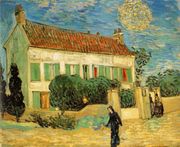
More or less acquainted with impressionist and neo-impressionist techniques and theories, Van Gogh went to Arles to develop these new possibilities. But within a short time, older ideas on art and work reappeared: ideas like doing series on related or contrasting subject matter, which would reflect the purpose of art. Already in 1884 in Nuenen he had worked on a series that was to decorate the dining room of a friend in Eindhoven. Similarly in Arles, in spring 1888 he arranged his Flowering Orchards into triptychs, began a series of figures which found its end in The Roulin Family, and finally, when Gauguin had consented to work and live in Arles side by side with Vincent, he started to work on the The Décoration for the Yellow House, probably the most ambitious effort he ever undertook. Most of his later work is elaborating or revising its fundamental settings.
The paintings from the Saint-Rémy period are often characterized by swirls and spirals. The patterns of luminosity in these images have been shown to conform to Kolmogorov's statistical model of turbulence. At various times in his life Van Gogh painted the view from his window; this culminated in the great series of paintings of the wheat field he could see from his adjoining cells in the asylum at Saint-Rémy.
Legacy
- Posthumous fame
Since his first exhibits in the late 1880s, Van Gogh's fame grew steadily, among his colleagues and among art critics, dealers and collectors. After his death, memorial exhibitions were mounted in Brussels, Paris, The Hague and Antwerp. In the early 20th century, the exhibitions were followed by vast retrospectives in Paris (1901 and 1905), Amsterdam (1905), Cologne (1912), New York City (1913) and Berlin (1914). These prompted a noticeable impact over a new generation of artists.
- Influence on art
The French Fauves, including Henri Matisse, extended both his use of colour and freedom in applying it, as did German Expressionists in the Die Brücke group. The 1950s' Abstract Expressionism is seen as benefiting from the exploration Van Gogh started with gestural marks. In 1957, Anglo-Irish artist Francis Bacon based several paintings on reproductions of Van Gogh's The Painter on his Way to Work (which had been destroyed during World War II).
- Cultural depictions
He has been the subject or inspiration for a number of different works, including films, and classical and popular music, including Don McLean's 1971 ballad " Vincent", also known by its opening words, "Starry Starry Night," which refer to the painting The Starry Night.




